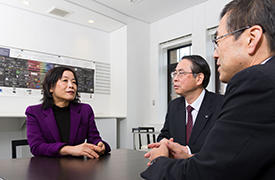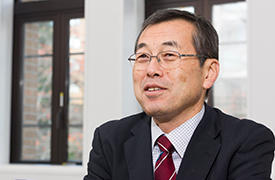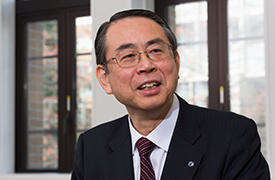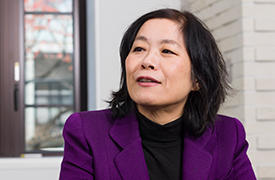

11/27/2017

On 30 June 2017, the Ministry of Education, Culture, Sports, Science and Technology (MEXT) announced that Tohoku University would become a Designated National University, along with the University of Tokyo and Kyoto University. Under this new framework, the selected universities have been charged with honing their international competitive edge by pursuing world-class education and research.
Prior to the application, Tohoku University had assessed its strengths and weaknesses and discussed its university-wide vision for the coming decades. The university will now focus on strengthening its research over the long term based on concepts established by the whole institution. In particular, it will pool its outstanding resources to create world-class research centers in four fields that the university is already strong in — materials science, spintronics, next-generation medical care and disaster science.
Tohoku University's strength in materials science is due to the depth of its expertise and its many researchers working in the area. Drawing on these advantages, the university will form a world-leading research center in materials science. The Advanced Institute for Materials Research (AIMR) will play a leading role in this new center, in collaboration with the Institute for Materials Research (IMR) and the Institute of Multidisciplinary Research for Advanced Materials (IMRAM), the Graduate School of Engineering and the Graduate School of Science.
Researchers are spurred on when they receive global recognition for their research. “In my view, it is important to ensure that we release as many research results as possible that can be regarded as world leading,” says Koki Takanashi, IMR’s director. Tohoku University operates on the principle of practice-oriented research and education. Researchers at the university believe that academic interest is not the only driving motivation; rather, they seek to make significant findings that will ultimately change society. The university will strive to further develop its strengths and accelerate the process of turning world top-level research into disruptive innovations. “Not only is this a tradition of ours, but it is also a point where Tohoku University can play a leading role,” adds Takanashi.

To create centers that attract excellent researchers from all around the world, it is vital for Japanese universities to pursue internationalization. In general, Japanese universities have fewer overseas students and researchers than universities in other countries, and the number of young Japanese students and researchers spending extended periods overseas is decreasing.
“I believe we have to become an internationally open university to which students and researchers come from around the world,” says Atsushi Muramatsu, IMRAM’s director. “At the same time, we need to encourage Japanese students and researchers to become more active overseas.”
“One key way for Japanese universities to join the global brain circulation is to develop an understanding of multiple cultures and realize that there is another world out there,” says Motoko Kotani, AIMR’s director. Researchers constantly explore new territories that lie at the margins of disciplines and are inspired by the interactions between different worlds.
Tohoku University is recognized as being strong in materials science. Each institute and department within the university has different strengths and specialties. AIMResearch talked to the three institute directors about those of their institutes.

Takanashi: To date, the IMR has emphasized fundamental research, but an important aspect of our work involves going beyond it. We strive to commercialize our findings based on the principle of practice-oriented research and education. The IMR has 100 years of experience in doing this. A good example of how fundamental research has bolstered industry is Sendust — a magnetic alloy invented at our institute over 80 years ago and still widely used in magnetic heads and other components. Another example is the high-performance sintered neodymium–iron–boron permanent magnets developed by Masato Sagawa when he joined a company after conducting research for his PhD at our institute. Neodymium magnets have become indispensable today. Both of these are magnetic materials, and these achievements can be considered part of Kotaro Honda’s legacy, the founding director of the IMR, who developed the strongest magnets in the world at that time. Of course, the IMR has also developed many valuable non-magnetic materials, and we continue to strive to apply fundamental research to practical applications by setting up venture companies.
Muramatsu: Traditionally, the IMRAM has tackled research targeting resources and materials — not only metals, but also oxides, sulfides, ceramics, as well as organic and biomaterials. Hence, we cover a rather broad range of materials science fields. But that doesn’t mean that we work haphazardly in a wide range of fields. Broadly speaking, our research falls into three main themes. The first is using inorganic materials with new functions, including recycling scarce resources. The second is scientific measurements for analyzing all kinds of materials. Under this theme, progress is being made on the Synchrotron Light in Tohoku, Japan (SLiT-J) project, a plan to develop a synchrotron facility in the Tohoku region of Japan. Thirdly, we are exploring and developing hybrid materials made from organic and inorganic sources, which will enable the development of materials possessing multiple functions. This is an area of research not widely investigated by other research centers. I want our institute to utilize its strengths to help consolidate materials science at Tohoku University, while compensating areas in which other departments are lacking.
Kotani: Since the AIMR was launched under the World Premier International Research Center Initiative (WPI) in 2007, our mission as a WPI center has been to advance the frontiers of science by attracting talented researchers from around the world. The AIMR is also seeking to promote cross-disciplinary research to create new scientific fields. In particular, we have been exploring the interface between mathematics and materials science — AIMR is the first center in the world to do this at an institutional level. Tohoku University’s bid to become a Designated National University was bolstered by AIMR’s achievements under the WPI program. As part of its strategy to generate world-leading research, Tohoku University established a Research Innovation System that has three foundational layers, consisting of groups of departments (including schools and graduate schools), interdisciplinary research alliances (including research institutes, international joint graduate programs and other institutions), and an Organization for Advanced Studies. The AIMR, which is in the Organization for Advanced Studies, has a vital mission to pursue world-leading research. The AIMR also plays a major role in creating new science by conducting cross-disciplinary research and using mathematics and information technology.
These three materials-science based institutes will forge ahead with this project playing their respective roles. “It is my hope that we can link the AIMR’s innovation to areas of practice-oriented research that the institutes and departments of Tohoku University, such as the IMR and the IMRAM, have traditionally addressed, so that we can sustainably grow stronger across the whole university,” Takanashi says. He stresses that the key to success lies in the cooperation between three fundamental layers in the university’s innovation system.
Muramatsu thinks it is important to actively exchange human resources and to improve the system within the new materials research center. “I believe it is necessary to promote personnel exchange that transcends the borders of institutes or departments, as exemplified by the Ensemble Project for Young Researchers, which we are currently implementing,” he says.

As stated in the purpose of the Designated National University program, it is vital for Japanese universities to enhance their international competitiveness. Yet Kotani says, “Despite the term ‘international competitiveness,’ I feel it does not mean competition; rather, it refers to an era of international partnership, in which researchers are like players performing together in a musical ensemble.”
Under the WPI program, the AIMR has constructed a framework for international joint research. It has also established joint-appointment post-doctoral researchers in the joint laboratories set up in its satellites and sought out the best partners with whom they could achieve joint research with other countries. This results in a win–win situation and best-with-best relationships, and creates an environment where researchers can ’perform’ together.
“Active participation in international joint research would allow us to discover the advantages on both sides. I hope we can increase opportunities to make foreign researchers think ‘Japan has many benefits; I want to go there’,” says Takanashi.
Moreover, the university will launch an international joint graduate program in materials science to promote international collaboration in education. The new initiative will consider strategies for assisting students to create international networks. These students will go on to become the next generation of leaders.
“We should consolidate friendly relationships with China, South Korea and Southeast Asia,” Muramatsu says. Japan’s research investment is gradually declining, but in terms of fundamental science, it remains as strong as ever. Meanwhile, China and South Korea have accelerated research investment and developed human resources at an enormous speed, so Japanese universities may be able to form very good collaborations if they can combine the fundamental science with their strengths. “I think we should take the opportunity presented by our appointment as a Designated National University to further solidify such collaboration,” Muramatsu adds.
Tohoku University has over 100 years of history in materials science. Building on this proud tradition, the university intends to establish a new paradigm of materials science through the innovation system of brain circulation being promoted inside and outside the university. Tohoku University’s status as a Designated National University has given it the chance to analyze and understand itself. Thus, the designation provides the perfect impetus to create a world-leading research center in materials science that attracts skilled researchers from around the world.